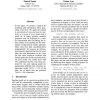Free Online Productivity Tools
i2Speak
i2Symbol
i2OCR
iTex2Img
iWeb2Print
iWeb2Shot
i2Type
iPdf2Split
iPdf2Merge
i2Bopomofo
i2Arabic
i2Style
i2Image
i2PDF
iLatex2Rtf
Sci2ools
79
Voted
COLING
2008
2008
A Joint Information Model for N-Best Ranking
In this paper, we present a method for modeling joint information when generating n-best lists. We apply the method to a novel task of characterizing the similarity of a group of terms where only a small set of many possible semantic properties may be displayed to a user. We demonstrate that considering the results jointly, by accounting for the information overlap between results, generates better n-best lists than considering them independently. We propose an information theoretic objective function for modeling the joint information in an n-best list and show empirical evidence that humans prefer the result sets produced by our joint model. Our results show with 95% confidence that the n-best lists generated by our joint ranking model are significantly different from a baseline independent model 50.0%
COLING 2008 | Computational Linguistics | Joint Information | Possible Semantic Properties | Small Set |
Related Content
| Added | 09 Dec 2010 |
| Updated | 09 Dec 2010 |
| Type | Journal |
| Year | 2008 |
| Where | COLING |
| Authors | Patrick Pantel, Vishnu Vyas |
Comments (0)

